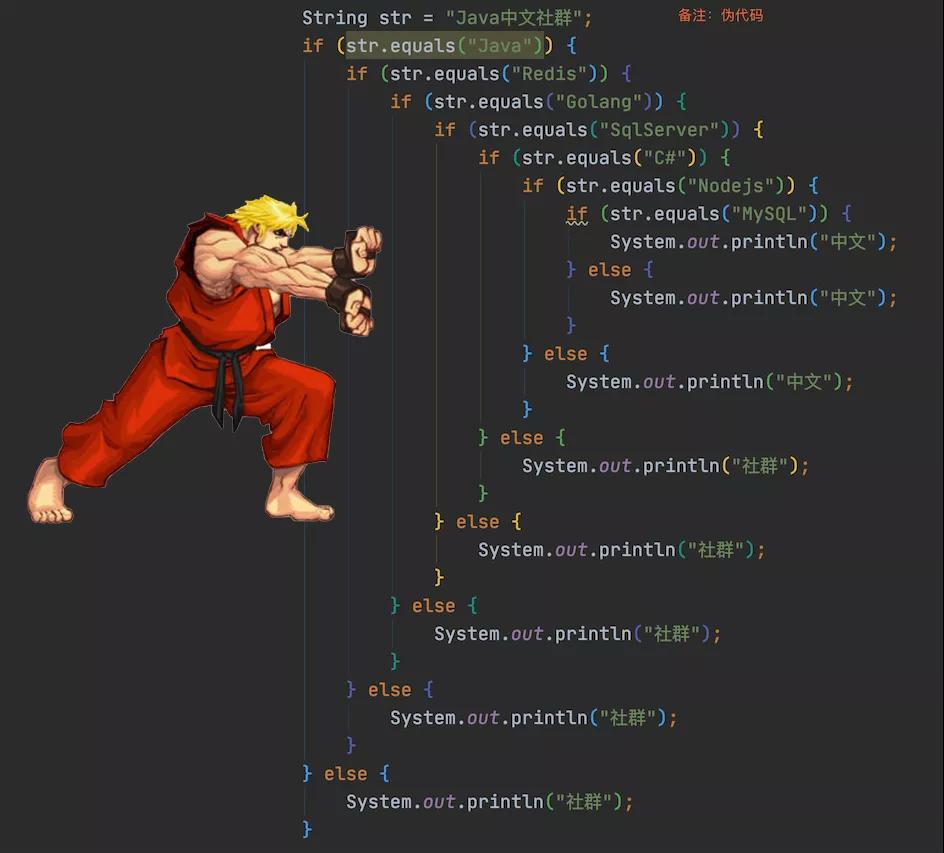жӮЁеҘҪпјҢзҷ»еҪ•еҗҺжүҚиғҪдёӢи®ўеҚ•е“ҰпјҒ
жң¬зҜҮеҶ…е®№д»Ӣз»ҚдәҶвҖңи§ЈеҶіеҶҷif elseзғҰжҒјж–№жі•жңүе“ӘдәӣвҖқзҡ„жңүе…ізҹҘиҜҶпјҢеңЁе®һйҷ…жЎҲдҫӢзҡ„ж“ҚдҪңиҝҮзЁӢдёӯпјҢдёҚе°‘дәәйғҪдјҡйҒҮеҲ°иҝҷж ·зҡ„еӣ°еўғпјҢжҺҘдёӢжқҘе°ұи®©е°Ҹзј–еёҰйўҶеӨ§е®¶еӯҰд№ дёҖдёӢеҰӮдҪ•еӨ„зҗҶиҝҷдәӣжғ…еҶөеҗ§пјҒеёҢжңӣеӨ§е®¶д»”з»Ҷйҳ…иҜ»пјҢиғҪеӨҹеӯҰжңүжүҖжҲҗпјҒ
if else жҳҜжҲ‘们еҶҷд»Јз Ғж—¶пјҢдҪҝз”Ёйў‘зҺҮжңҖй«ҳзҡ„е…ій”®иҜҚд№ӢдёҖпјҢ然иҖҢжңүж—¶иҝҮеӨҡзҡ„ if else дјҡи®©жҲ‘们ж„ҹеҲ°и„‘еЈіз–јгҖӮ
дҫӢеҰӮдёӢйқўиҝҷдёӘдјӘд»Јз Ғпјҡ

жҳҜдёҚжҳҜеҫҲеҙ©жәғ?иҷҪ然他жҳҜдјӘд»Јз ҒпјҢ并且зңӢиө·жқҘд№ҹеҫҲеӨёеј пјҢдҪҶеңЁзҺ°е®һдёӯпјҢеҪ“жҲ‘д»¬ж— ж•°ж¬Ў Review еҲ«дәәд»Јз Ғж—¶пјҢйғҪдјҡеҸ‘зҺ°зұ»дјјзҡ„еңәжҷҜгҖӮ
жҲ‘们жң¬ж–ҮжҸҗдҫӣдәҶ 9 з§Қж–№жі•жқҘи§ЈеҶіжҺүйӮЈдәӣвҖңзғҰдәәвҖқзҡ„ if elseпјҢдёҖиө·жқҘзңӢеҗ§гҖӮ
1.дҪҝз”Ё return
жҲ‘们дҪҝз”Ё return еҺ»жҺүеӨҡдҪҷзҡ„ elseпјҢе®һзҺ°д»Јз ҒеҰӮдёӢгҖӮ
дјҳеҢ–еүҚд»Јз Ғпјҡ
if ("java".equals(str)) { // дёҡеҠЎд»Јз Ғ...... } else { return; }дјҳеҢ–еҗҺд»Јз Ғпјҡ
if (!"java".equals(str)) { return; } // дёҡеҠЎд»Јз Ғ......иҝҷж ·зңӢиө·жқҘе°ұдјҡиҲ’жңҚеҫҲеӨҡпјҢиҷҪ然зӣёе·®еҸӘжңүдёҖиЎҢд»Јз ҒпјҢдҪҶзңҹжӯЈзҡ„й«ҳжүӢе’Ңжҷ®йҖҡдәәд№Ӣй—ҙзҡ„е·®и·қе°ұжҳҜд»ҺиҝҷдёҖиЎҢиЎҢд»Јз ҒдёӯдҪ“зҺ°еҮәжқҘзҡ„гҖӮ
вҖңеӢҝд»Ҙе–„е°ҸиҖҢдёҚдёәпјҢеӢҝд»ҘжҒ¶е°ҸиҖҢдёәд№ӢвҖқпјҢвҖңеҚғйҮҢд№Ӣе ӨпјҢжәғдәҺиҡҒз©ҙвҖқпјҢиҜҙзҡ„йғҪжҳҜеҗҢж ·зҡ„йҒ“зҗҶгҖӮ
2.дҪҝз”Ё Map
дҪҝз”Ё Map ж•°з»„пјҢжҠҠзӣёе…ізҡ„еҲӨж–ӯдҝЎжҒҜпјҢе®ҡд№үдёәе…ғзҙ дҝЎжҒҜеҸҜд»ҘзӣҙжҺҘйҒҝе…Қ if else еҲӨж–ӯпјҢе®һзҺ°д»Јз ҒеҰӮдёӢгҖӮ
дјҳеҢ–еүҚд»Јз Ғпјҡ
if (t == 1) { type = "name"; } else if (t == 2) { type = "id"; } else if (t == 3) { type = "mobile"; }жҲ‘们е…Ҳе®ҡд№үдёҖдёӘ Map ж•°з»„пјҢжҠҠзӣёе…іеҲӨж–ӯдҝЎжҒҜеӯҳеӮЁиө·жқҘпјҡ
Map<Integer, String> typeMap = new HashMap<>(); typeMap.put(1, "name"); typeMap.put(2, "id"); typeMap.put(3, "mobile");
д№ӢеүҚзҡ„еҲӨж–ӯиҜӯеҸҘеҸҜд»ҘдҪҝз”Ёд»ҘдёӢдёҖиЎҢд»Јз Ғд»ЈжӣҝдәҶпјҡ
type = typeMap.get(t);
3.дҪҝз”Ёдёүе…ғиҝҗз®—з¬Ұ
дёүе…ғиҝҗз®—з¬Ұд№ҹеҸ«дёүе…ғиЎЁиҫҫејҸжҲ–иҖ…дёүзӣ®иҝҗз®—з¬Ұ/иЎЁиҫҫејҸпјҢдёҚиҝҮд»ЈиЎЁзҡ„йғҪжҳҜдёҖдёӘж„ҸжҖқпјҢдјҳеҢ–д»Јз ҒеҰӮдёӢгҖӮ
дјҳеҢ–еүҚд»Јз Ғпјҡ
Integer score = 81; if (score > 80) { score = 100; } else { score = 60; }дјҳеҢ–еҗҺд»Јз Ғпјҡ
score = score > 80 ? 100 : 60;
4.еҗҲ并жқЎд»¶иЎЁиҫҫејҸ
еңЁйЎ№зӣ®дёӯжңүдәӣйҖ»иҫ‘еҲӨж–ӯжҳҜеҸҜд»ҘйҖҡиҝҮжўізҗҶе’ҢеҪ’зәіпјҢеҸҳжӣҙдёәжӣҙз®ҖеҚ•жҳ“жҮӮзҡ„йҖ»иҫ‘еҲӨж–ӯд»Јз ҒпјҢеҰӮдёӢжүҖзӨәгҖӮ
дјҳеҢ–еүҚд»Јз Ғпјҡ
String city = "иҘҝе®ү"; String area = "029"; String province = "йҷ•иҘҝ"; if ("иҘҝе®ү".equals(city)) { return "xi'an"; } if ("029".equals(area)) { return "xi'an"; } if ("йҷ•иҘҝ".equals(province)){ return "xi'an"; }дјҳеҢ–еҗҺд»Јз Ғпјҡ
if ("иҘҝе®ү".equals(city) || "029".equals(area) || "йҷ•иҘҝ".equals(province)){ return "xi'an"; }5.дҪҝз”Ёжһҡдёҫ
JDK 1.5 дёӯеј•е…ҘдәҶж–°зҡ„зұ»еһӢ——жһҡдёҫ(enum)пјҢжҲ‘们дҪҝз”Ёе®ғеҸҜд»Ҙе®ҢжҲҗеҫҲеӨҡеҠҹиғҪпјҢдҫӢеҰӮдёӢйқўиҝҷдёӘгҖӮ
дјҳеҢ–еүҚд»Јз Ғпјҡ
Integer typeId = 0; String type = "Name"; if ("Name".equals(type)) { typeId = 1; } else if ("Age".equals(type)) { typeId = 2; } else if ("Address".equals(type)) { typeId = 3; }дјҳеҢ–ж—¶пјҢжҲ‘们е…ҲжқҘе®ҡд№үдёҖдёӘжһҡдёҫпјҡ
public enum TypeEnum { Name(1), Age(2), Address(3); public Integer typeId; TypeEnum(Integer typeId) { this.typeId = typeId; } }д№ӢеүҚзҡ„ if else еҲӨж–ӯе°ұеҸҜд»Ҙиў«еҰӮдёӢдёҖиЎҢд»Јз ҒжүҖжӣҝд»ЈдәҶпјҡ
typeId = TypeEnum.valueOf("Name").typeId;6.дҪҝз”Ё Optional
д»Һ JDK 1.8 ејҖе§Ӣеј•е…Ҙ Optional зұ»пјҢеңЁ JDK 9 ж—¶еҜ№ Optional зұ»иҝӣиЎҢдәҶж”№иҝӣпјҢеўһеҠ дәҶ ifPresentOrElse() ж–№жі•пјҢжҲ‘们еҸҜд»ҘеҖҹеҠ©е®ғпјҢжқҘж¶ҲйҷӨ if else зҡ„еҲӨж–ӯпјҢдҪҝз”ЁеҰӮдёӢгҖӮ
дјҳеҢ–еүҚд»Јз Ғпјҡ
String str = "java"; if (str == null) { System.out.println("Null"); } else { System.out.println(str); }дјҳеҢ–еҗҺд»Јз Ғпјҡ
Optional<String> opt = Optional.of("java"); opt.ifPresentOrElse(v -> System.out.println(v), () -> System.out.println("Null"));е°ҸиҙҙеЈ«пјҡжіЁж„ҸиҝҗиЎҢзүҲжң¬пјҢеҝ…йЎ»жҳҜ JDK 9+ жүҚиЎҢгҖӮ
7.жўізҗҶдјҳеҢ–еҲӨж–ӯйҖ»иҫ‘
е’Ң第 4 зӮ№жҜ”иҫғзұ»дјјпјҢжҲ‘们еҸҜд»ҘйҖҡиҝҮеҲҶжһҗ if else зҡ„йҖ»иҫ‘еҲӨж–ӯиҜӯд№үпјҢеҶҷеҮәжӣҙеҠ жҳ“жҮӮзҡ„д»Јз ҒпјҢдҫӢеҰӮд»ҘдёӢиҝҷдёӘеөҢеҘ—еҲӨж–ӯзҡ„дјҳеҢ–гҖӮ
дјҳеҢ–еүҚд»Јз Ғпјҡ
// е№ҙйҫ„еӨ§дәҺ 18 if (age > 18) { // е·Ҙиө„еӨ§дәҺ 5000 if (salary > 5000) { // жҳҜеҗҰжјӮдә® if (pretty == true) { return true; } } } return false;дјҳеҢ–еҗҺд»Јз Ғпјҡ
if (age < 18) { return false; } if (salary < 5000) { return false; } return pretty;жҲ‘们йңҖиҰҒе°ҪйҮҸжҠҠиЎЁиҫҫејҸдёӯзҡ„еҢ…еҗ«е…ізі»ж”№дёәе№іиЎҢе…ізі»пјҢиҝҷж ·д»Јз ҒеҸҜиҜ»жҖ§жӣҙй«ҳпјҢйҖ»иҫ‘жӣҙжё…жҷ°гҖӮ
8.дҪҝз”ЁеӨҡжҖҒ
继жүҝгҖҒе°ҒиЈ…е’ҢеӨҡжҖҒжҳҜ OOP(йқўеҗ‘еҜ№иұЎзј–зЁӢ)зҡ„йҮҚиҰҒжҖқжғіпјҢжң¬ж–ҮжҲ‘们дҪҝз”ЁеӨҡжҖҒзҡ„жҖқжғіпјҢжҸҗдҫӣдёҖз§ҚеҺ»йҷӨ if else ж–№жі•гҖӮ
дјҳеҢ–еүҚд»Јз Ғпјҡ
Integer typeId = 0; String type = "Name"; if ("Name".equals(type)) { typeId = 1; } else if ("Age".equals(type)) { typeId = 2; } else if ("Address".equals(type)) { typeId = 3; }дҪҝз”ЁеӨҡжҖҒпјҢжҲ‘们е…Ҳе®ҡд№үдёҖдёӘжҺҘеҸЈпјҢеңЁжҺҘеҸЈдёӯеЈ°жҳҺдёҖдёӘе…¬е…ұиҝ”еӣһ typeId зҡ„ж–№жі•пјҢеңЁж·»еҠ дёүдёӘеӯҗзұ»еҲҶеҲ«е®һзҺ°иҝҷдёүдёӘеӯҗзұ»гҖӮ
е®һзҺ°д»Јз ҒеҰӮдёӢпјҡ
public interface IType { public Integer getType(); } public class Name implements IType { @Override public Integer getType() { return 1; } } public class Age implements IType { @Override public Integer getType() { return 2; } } public class Address implements IType { @Override public Integer getType() { return 3; } }жіЁж„ҸпјҡдёәдәҶз®ҖдҫҝжҲ‘们иҝҷйҮҢжҠҠзұ»е’ҢжҺҘеҸЈж”ҫеҲ°дәҶдёҖдёӘд»Јз Ғеқ—дёӯпјҢеңЁе®һйҷ…ејҖеҸ‘дёӯеә”иҜҘеҲҶеҲ«еҲӣе»әдёҖдёӘжҺҘеҸЈе’ҢдёүдёӘзұ»еҲҶеҲ«еӯҳеӮЁгҖӮ
жӯӨж—¶пјҢжҲ‘们д№ӢеүҚзҡ„ if else еҲӨж–ӯе°ұеҸҜд»Ҙж”№дёәеҰӮдёӢд»Јз Ғпјҡ
IType itype = (IType) Class.forName("com.example." + type).newInstance(); Integer typeId = itype.getType();жңүдәәеҸҜиғҪдјҡиҜҙпјҢиҝҷж ·еҸҚиҖҢи®©д»Јз ҒжӣҙеҠ еӨҚжқӮдәҶпјҢжӯӨеҸҜи°“вҖңжқҖйёЎз„үз”Ёе®°зүӣеҲҖвҖқзҡ„е…ёеһӢиҢғдҫӢдәҶгҖӮ
иҝҷйҮҢдҪңиҖ…еҸӘжҳҜжҸҗдҫӣдёҖз§Қе®һзҺ°жҖқи·Ҝе’ҢжҸҗдҫӣдәҶдёҖдәӣз®Җжҳ“зүҲзҡ„д»Јз ҒпјҢд»ҘдҫӣејҖеҸ‘иҖ…еңЁе®һйҷ…ејҖеҸ‘дёӯпјҢеӨҡдёҖз§ҚжҖқи·Ҝе’ҢйҖүжӢ©пјҢе…·дҪ“з”ЁдёҚз”ЁйңҖиҰҒж №жҚ®е®һйҷ…жғ…еҶөжқҘе®ҡдәҶгҖӮзҒөжҙ»еҸҳйҖҡпјҢдёҫдёҖеҸҚдёүпјҢжүҚжҳҜејҖеҸ‘зҡ„дёҠд№ҳеҝғжі•гҖӮ
9.йҖүжӢ©жҖ§зҡ„дҪҝз”Ё switch
еҫҲеӨҡдәәйғҪжҗһдёҚжҮӮ switch е’Ң if else зҡ„дҪҝз”ЁеңәжҷҜпјҢдҪҶеңЁдёӨиҖ…йғҪиғҪдҪҝз”Ёзҡ„жғ…еҶөдёӢпјҢеҸҜд»Ҙе°ҪйҮҸдҪҝз”Ё switchпјҢеӣ дёә switch еңЁеёёйҮҸеҲҶж”ҜйҖүжӢ©ж—¶пјҢswitch жҖ§иғҪдјҡжҜ” if else й«ҳгҖӮ
if else еҲӨж–ӯд»Јз Ғпјҡ
if ("add".equals(cmd)) { result = n1 + n2; } else if ("subtract".equals(cmd)) { result = n1 - n2; } else if ("multiply".equals(cmd)) { result = n1 * n2; } else if ("divide".equals(cmd)) { result = n1 / n2; } else if ("modulo".equals(cmd)) { result = n1 % n2; }switch д»Јз Ғпјҡ
switch (cmd) { case "add": result = n1 + n2; break; case "subtract": result = n1 - n2; break; case "multiply": result = n1 * n2; break; case "divide": result = n1 / n2; break; case "modulo": result = n1 % n2; break; }еңЁ Java 14 еҸҜдҪҝз”Ё switch д»Јз Ғеқ—пјҢе®һзҺ°д»Јз ҒеҰӮдёӢпјҡ
// java 14 switch (cmd) { case "add" -> { result = n1 + n2; } case "subtract" -> { result = n1 - n2; } case "multiply" -> { result = n1 * n2; } case "divide" -> { result = n1 / n2; } case "modulo" -> { result = n1 % n2; } }вҖңи§ЈеҶіеҶҷif elseзғҰжҒјж–№жі•жңүе“ӘдәӣвҖқзҡ„еҶ…е®№е°ұд»Ӣз»ҚеҲ°иҝҷйҮҢдәҶпјҢж„ҹи°ўеӨ§е®¶зҡ„йҳ…иҜ»гҖӮеҰӮжһңжғідәҶи§ЈжӣҙеӨҡиЎҢдёҡзӣёе…ізҡ„зҹҘиҜҶеҸҜд»Ҙе…іжіЁдәҝйҖҹдә‘зҪ‘з«ҷпјҢе°Ҹзј–е°ҶдёәеӨ§е®¶иҫ“еҮәжӣҙеӨҡй«ҳиҙЁйҮҸзҡ„е®һз”Ёж–Үз« пјҒ
е…ҚиҙЈеЈ°жҳҺпјҡжң¬з«ҷеҸ‘еёғзҡ„еҶ…е®№пјҲеӣҫзүҮгҖҒи§Ҷйў‘е’Ңж–Үеӯ—пјүд»ҘеҺҹеҲӣгҖҒиҪ¬иҪҪе’ҢеҲҶдә«дёәдё»пјҢж–Үз« и§ӮзӮ№дёҚд»ЈиЎЁжң¬зҪ‘з«ҷз«ӢеңәпјҢеҰӮжһңж¶үеҸҠдҫөжқғиҜ·иҒ”зі»з«ҷй•ҝйӮ®з®ұпјҡis@yisu.comиҝӣиЎҢдёҫжҠҘпјҢ并жҸҗдҫӣзӣёе…іиҜҒжҚ®пјҢдёҖз»ҸжҹҘе®һпјҢе°Ҷз«ӢеҲ»еҲ йҷӨж¶үе«ҢдҫөжқғеҶ…е®№гҖӮ
жӮЁеҘҪпјҢзҷ»еҪ•еҗҺжүҚиғҪдёӢи®ўеҚ•е“ҰпјҒ